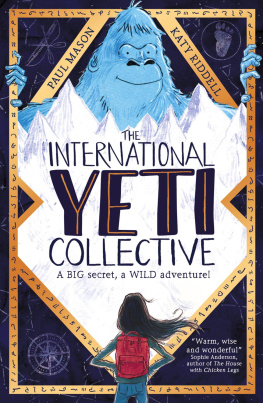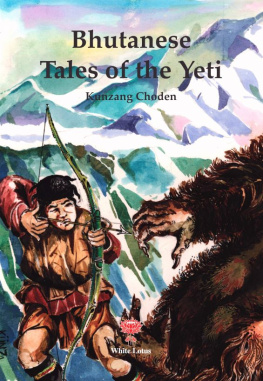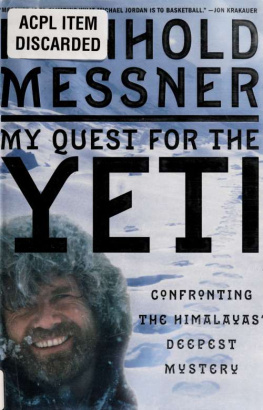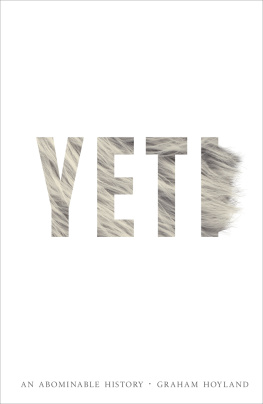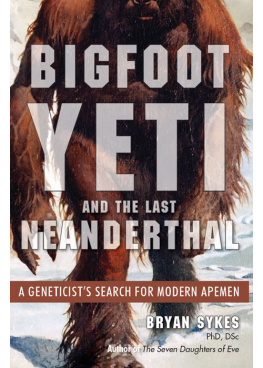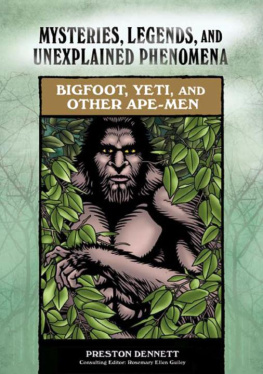Any book from Daniel Taylor is an occasion for celebration. No one knows or has thought more about the complex fusion of culture, landscape and spirit that is the very essence of the Himalaya. The story of the Yeti distills all of this magic into a single beam of illumination. And into this light walks Daniel, always the scientist, who reveals the truth, but in a way that only fires further the imaginations of all of us.
Wade Davis , Professor of Anthropology and Ecosystems at Risk, University of British Columbia, Canada
Three decades have passed since I met Daniel Taylor ... Together we established a nature preserve as an abode for all creatures, mythical as the Yeti or real as bears ... Still people are calling Abominable Snowman to the innocent Yeti who resides in the hearts of mountain people, who adds life in their arts and culture, and overall who helped them to raise their livelihood through tourism. I am thrilled Daniel has come up once again with ... the secrets of nature in the highest terrestrial ecosystem of this living planet.
Tirtha B. Shrestha , Life Member, Nepal Academy, Kathmandu, Nepal
A mystery wrapped in an enigma wrapped in one hell of a yarnand with big implications not just for protecting the Himalayas, but for the way we think about the world.
Bill McKibben , environmentalist, author of Deep Economy: The Wealth of Communities and the Durable Future , and founder of 350.org
In one fell stroke of clarity, Daniel Taylor has re-written the history books and rid us of a decades old fantasythat of an as-yet-undiscovered higher beinghigher at least in terms of altitude, if not the smarts to elude us for over a half century! The Yeti of the Himalaya (remember the cover of Tintin in Tibet ?), Bigfoot or Sasquach of North America and the Mande Burung of Meghalayaall have been put to rest in one go! Yeti slayer or eco-chronicler cum geographer extraordinairecall him what you will, Daniel Taylor is a true Himalayan soul who has traversed the mountains from Arunachal to Uttarakhandfrom a childhood in Landour to his more recent years spent in education and conservation, spanning a sixty-year swathe of time. He can speak to the people of the Himalaya and of the animals, with equal poise. He speaks as much to the city-dweller as to all who also make the wild part of their lives. Indeed, over the years Daniel has made the high altitude wildernesses a part of his life! He takes us along on a journey from the wilds of India that he grew up in to the equally challenging wilds of the new age, in a particularly well-written series of lucid essays that are Thoreau-like at one level and Gerard Manley Hopkins-esque in their poetic thoughtfulness, at another. Unstoppable and unputdownableyou run the real risk of throwing it all away and heading to the mountains up north when youre done with the stories of Daniels Himalayan lifetime as told in this book! Go for it ...
Rupin Dang , filmmaker, Wilderness Films India
YETI

One of the authors yak caravans, crossing Shao La Pass, the place where the Yeti was sighted in 1921 by the Everest Reconnaissance Expedition
Source : Author
YETI
The Ecology of a Mystery
Daniel C. Taylor


Oxford University Press is a department of the University of Oxford.
It furthers the Universitys objective of excellence in research, scholarship,
and education by publishing worldwide. Oxford is a registered trademark of
Oxford University Press in the UK and in certain other countries.
Published in India by
Oxford University Press
2/11 Ground Floor, Ansari Road, Daryaganj, New Delhi 110 002, India
Daniel C. Taylor 2017
The moral rights of the author have been asserted.
First Edition published in 2017
All rights reserved. No part of this publication may be reproduced, stored in
a retrieval system, or transmitted, in any form or by any means, without the
prior permission in writing of Oxford University Press, or as expressly permitted
by law, by licence, or under terms agreed with the appropriate reprographics
rights organization. Enquiries concerning reproduction outside the scope of the
above should be sent to the Rights Department, Oxford University Press, at the
address above.
You must not circulate this work in any other form
and you must impose this same condition on any acquirer.
ePub ISBN-13: 978-0-19-909136-2
ePub ISBN-10: 0-19-909136-6
Typeset in Goudy Oldstyle Std 11/14.3
by Tranistics Data Technologies, Kolkata 700091
Printed in India by Replika Press Pvt. Ltd
Go and look behind the Ranges
Something lost behind the Ranges.
Lost and waiting for you. Go!
So I went, worn out of patience;
never told my nearest neighbours
Stole away with pack and ponies
left em drinking in the town;
And the faith that moveth mountains
didnt seem to help my labours
As I faced the sheer main-ranges,
whipping up and leading down.
Till a voice, as bad as Conscience,
rang interminable changes
In one everlasting Whisper
day and night repeated so:
Something hidden. Go and find it.
Rudyard Kipling
To the people of Shyakshila Village, Nepal, who protect the Barun Valley and the Yeti
And to you who nurture the wild in your lives
Contents
This story traces an arc from my boyhood in the Himalaya, chasing monkeys from my toys, through launching two national parks surrounding Mount Everest. What connects monkeys chased from toys and national parks around Mount Everest is the Yeti.
About this mystery of the Yeti, Himalayan legends assert that an animal much like humans inhabits the snows around Mount Everest. Turning the legends to serious inquiry are footprints. Stories do not make footprintsthus, if footprints exist, the maker of those footprints must also exist. And footprints that keep being found in the same basic structure across more than 100 years mean the evidence is not that of one aberrant animals trail, for if the prints were made by a freak, after some years that individual would die and the distinctive tracks would stop being found. Moreover, the same basic footprint found in multiple sizes suggest a population that is reproducing.
This book clarifies what animal leaves these footprints. Various explanations were being advanced when I began the search. The prints might be made by an unknown wild man who for more than a century had eluded identification. They might be by an unknown animal but non-hominoid, related perhaps to the giant panda or gorilla with whom the footprints shared intriguing resemblance. A third explanation was the maker was known, but not yet recognized as able to make human-looking prints. And, of course, a fourth possibilityYeti is a materialized spirit: not an animal, but a supernatural being, Science asserts, cannot, must not, exist.
Giving credence to the debate are always the footprints. That footprints were being found was never in doubt. Some thing was making footprints. Still today, the mysterious prints continue to be found. Photographs are repeatedly taken. Thus, the Yeti is real, for imagined animals do not make footprints. Footprints are made only by real animals. So, as with Mount Everest, the Yeti is there, and as with those who sought to climb Mount Everest, I began a search to explain the footprints.
Next page


